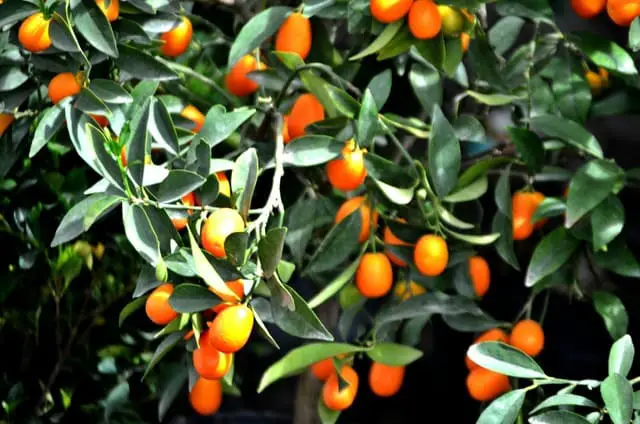Why People Graft Kumquat Tree
Kumquats, like other citrus trees, are susceptible diseases & pests in the ground if not well cared for. This is why people graft kumquat trees on strong rootstocks to increase their strength and tolerance.
Nematodes, the snake-like micro-organisms, usually attack the roots of kumquat trees, making it difficult for them to transport nutrients up & produce fruits. These small animals can't be seen by our naked eyes, but only under a microscope like this one.
Here are the nematode under a microscope:
/nematode-attack-kumquat-tree-root.jpg)
Additionally, a full size kumquat tree may be too big for small yards. Its roots may not be tolerant to frost in cold growing zones.
Grafting kumquat trees help them get a stronger foundation while making the size of the tree more manageable.
With a grafted kumquat tree, you can more confidently grow them in the ground (even with nematodes & freezing) and take the cuttings with you to grow new trees if/when you move to another city.
The Flying Dragon Rootstock
/poncirus-trifoliata-lemon-plant.jpg)
The rootstock people often use for grafting kumquat is Poncirus trifoliata (finger lime or microcitrus papuana) or the dwarf variety Poncirus trifoliata Flying Dragon. Citrumelo or C. macrophylla is also a good choice.
The finger lime rootstock has straight thorns, while the Flying Dragon has more curvy thorns. We're not sure which variety this one is, but the thorns look something like this:
/flying-dragon-thorn.jpg)
A compatible rootstock is important for your kumquat growth. An incompatible one might dry out the young buds & give it no growth at all.
Once a good rootstock has been selected, people use these grafting techniques to grow the trees.
Let's now have a look.
Citrus Grafting Techniques
/grafted-citrus-tree.jpg)
Here are some of the most common citrus grafting techniques many people use:
- T-budding
- Z-grafting
- Patch grafting
- Cleft grafting
- Bud grafting
For beginners, the easiest grafting method would be the T-budding. Using this method, you make a capital T on your Flying Dragon rootstock & insert the kumquat bud in.
The other techniques require some more practice. But if you're intrigued, let's have a sneak peak into how a master does the T-budding technique.
T-Bud Grafting Kumquat Tree
For this T-bud technique, you'll need:
- Grafting knife
- Alcohol
- Flying Dragon rootstock
- Kumquat bud
- Wax tape
- Clippers
Step 1: Clip Off the Thorns & Leaves of Flying Dragon
Before grafting, sterilize your grafting knife. Then, cut off the thorns & leaves on your rootstock. This helps cut off extra exit ways for the nutrients & concentrate them onto the kumquat bud we're about to graft on.
Step 2: Cut Your Kumquat Bud
Use your knife to slice off a piece of bud on your kumquat tree. The bud often looks like a bump (or a camel hump) on the stem. Here, Garden S used the Fortunella Hindsii kumquat. It's a small variety with tiny fruits that's great for bonsai.
Step 3: Make a T Cut on the Flying Dragon Rootstock
Now, with your grafting knife, make a T cut on the rootstock. Just about the length of the kumquat bud that you cut.
Step 4: Graft Your Kumquat Bud On & Wax Tape It
Carefully put your kumquat bud into the T opening. Make sure the vascular cambium of the scion & rootstock touch. This increases the take rate.
Then, use some wax tape to wrap around the graft. The tape helps hold the graft in place & keeps the bud from drying out.
When the bud starts to grow, it will poke through the tape.
Step 5: Finally Break Off Half of Your Rootstock
When we break off the rootstock, nutrients will not be going to the upper part of grafted side. This signals to the tree to move all the good bits to our baby side.
If we leave the branch as-is, apical dominance will move nutrients to the top parts first then come flushing down. Our grafted bud will receive the food later and thus slows down its growth. When all is done, we can begin the waiting game.
The Limitation of T-Budding Grafting
/citrus-cocktail-tree.jpg)
The limitation of the T-bud technique is that it may limit only one type of citrus to be grown on one rootstock. Because we need to break off the upper part of the branch, leaving less space for more grafts.
If we combine the other methods, we can grow some other types of citrus, creating our own citrus cocktail tree. Lemons, oranges, or kumquats all in one. But of course, we should emphasize compatibility once again.
If you want to check out more, here's an article on the different varieties of kumquat you might want to check out:
>> Link Blog post:

Share or pin this post!



